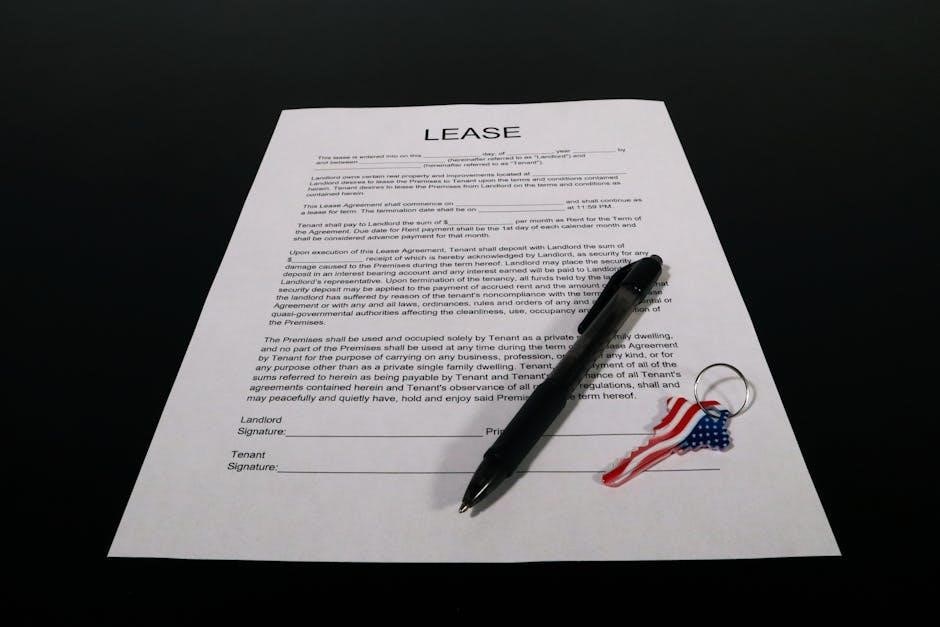A Promise to Pay Rent Agreement is a legally binding document outlining a tenant’s commitment to pay overdue rent, establishing a clear payment plan to avoid eviction and ensure mutual accountability between tenant and landlord.
1.1 Definition and Purpose
A Promise to Pay Rent Agreement, also known as a promissory note, is a legally binding document where a tenant formally commits to paying overdue rent. Its primary purpose is to establish a clear payment plan, avoiding eviction and ensuring the tenant addresses rental arrears. This agreement serves as formal acknowledgment of the debt, detailing the total amount owed, payment schedule, and due dates. It is not a replacement for a lease but rather a supplementary contract reaffirming the tenant’s obligation to fulfill rental responsibilities. By creating a structured repayment plan, both parties can avoid legal disputes and maintain a positive relationship. It provides clarity and security, ensuring timely payments and adherence to agreed terms.
1.2 Legal Recognition
A Promise to Pay Rent Agreement holds significant legal weight as a formally recognized and enforceable document under state laws. Courts acknowledge its validity, making it a powerful tool for resolving rental debt disputes. The agreement serves as concrete evidence of a tenant’s obligation to repay arrears and the agreed payment terms. Its binding nature ensures accountability for both parties, reinforcing the tenant’s commitment to fulfill financial responsibilities. Legal recognition provides landlords with a clear pathway to pursue remedies if payments fail, while offering tenants a structured plan to avoid eviction. By adhering to legal standards, the agreement prevents misunderstandings and ensures obligations are met fairly and transparently.

Importance of a Promise to Pay Rent Agreement
A Promise to Pay Rent Agreement is crucial for preventing eviction, providing clarity, and ensuring security for both tenants and landlords, fostering a positive relationship.
2.1 Preventing Eviction
A Promise to Pay Rent Agreement plays a vital role in preventing eviction by establishing a structured payment plan for overdue rent. This document allows tenants to demonstrate their commitment to settling arrears, providing landlords with assurance of payment. By outlining clear terms, including the amount owed and due dates, the agreement helps avoid legal eviction proceedings. It offers tenants a chance to rectify their financial obligations while maintaining their tenancy. The agreement also serves as a formal acknowledgment of debt, which can prevent landlords from taking immediate legal action. This proactive approach ensures both parties can resolve the issue amicably, preserving the tenant-landlord relationship and avoiding costly court interventions.
2.2 Clarity and Security for Both Parties
A Promise to Pay Rent Agreement provides clarity and security for both tenants and landlords by outlining clear payment terms, due dates, and late payment clauses. This document ensures transparency, preventing misunderstandings and disputes. It offers tenants a structured plan to address overdue rent while providing landlords with assurance of payment. The agreement is legally binding, protecting both parties’ interests and ensuring accountability. By detailing the total amount owed, payment schedules, and consequences of late payments, it creates a fair and secure framework for resolving rental debt. This clarity fosters trust and maintains a positive tenant-landlord relationship, ensuring obligations are met without ambiguity;
Key Components of the Agreement
The agreement includes essential details like parties involved, payment terms, due dates, late payment clauses, and signature requirements, ensuring clarity and enforceability for both tenant and landlord.
3.1 Parties Involved
The Promise to Pay Rent Agreement clearly identifies the parties involved, including the tenant and landlord. It requires the full legal names, addresses, and contact information of both parties to ensure accountability. The tenant, as the borrower, acknowledges the debt, while the landlord, as the creditor, agrees to the repayment terms. In some cases, witnesses or guarantors may also be included to strengthen the agreement’s enforceability. Both parties must sign the document to validate it, confirming their mutual understanding and commitment to the payment plan. This section ensures transparency and establishes a clear record of who is responsible for fulfilling the agreement’s terms.
3.2 Payment Terms and Conditions
The payment terms and conditions outline the specific details of how and when the tenant will pay the overdue rent. This includes the total amount owed, the payment schedule, and the method of payment. The agreement may specify whether payments will be made in installments or as a lump sum, with clear due dates for each payment. It may also include provisions for late payments, such as additional fees or penalties. Interest rates, if applicable, should be stated to ensure transparency. The terms must be agreed upon by both parties and clearly defined to avoid disputes. This section ensures that the tenant understands their financial obligations and the consequences of failing to meet them. By outlining these details, the agreement provides a structured plan for resolving the debt, benefiting both the landlord and the tenant. Proper documentation of these terms is essential for enforcing the agreement if necessary. This clarity helps maintain a professional relationship and ensures accountability from both sides. The payment terms and conditions are a critical component of the agreement, as they outline the roadmap for resolving the unpaid rent.
3.3 Due Dates and Late Payment Clauses
Due dates and late payment clauses are essential components of a Promise to Pay Rent Agreement, providing clarity on payment timelines and consequences for missed payments. The agreement specifies exact due dates for each payment, whether as a lump sum or installments. Late payment clauses outline penalties, such as flat fees or percentage-based interest, to incentivize timely payments. These terms are mutually agreed upon, ensuring both parties understand their obligations. If payments are late, landlords may pursue legal action or other remedies. Proper documentation of these clauses is crucial for enforcing the agreement and maintaining accountability. They help prevent disputes by establishing clear expectations and consequences, ensuring a structured approach to managing overdue rent.
3.4 Signature Requirements
A Promise to Pay Rent Agreement must be signed by both the tenant and landlord to ensure its validity and enforceability. Signatures formalize the mutual understanding of the payment plan and acknowledge the legally binding nature of the document. Witnesses or notarization may be required, depending on state laws, to strengthen the agreement’s legal standing. Proper signatures confirm that both parties agree to the terms and are committed to fulfilling their obligations. Without valid signatures, the document may not hold up in court, emphasizing the importance of adhering to these formalities. This step ensures the agreement is legally sound and protects both parties’ interests, providing a clear record of their commitment to the payment plan.

How to Create a Promise to Pay Rent Agreement
Create a Promise to Pay Rent Agreement by including specific details like payment terms, due dates, and signatures, ensuring legal compliance and clear accountability for both parties.
4.1 Step-by-Step Guide
Identify the parties involved, including tenant and landlord details. 2. Specify the total amount owed and outline a clear payment plan. 3. Define due dates for each payment. 4. Include late payment clauses and penalties. 5. Add signature requirements for both parties. 6. Use a template for efficiency and customization. 7; Ensure legal compliance by adhering to state laws. 8. Consult a legal expert if necessary. 9. Execute the agreement and store copies for both parties. This structured approach ensures clarity and enforceability, protecting both tenant and landlord interests while resolving rental debt effectively.
4.2 Ensuring Legal Compliance
Ensuring legal compliance is crucial when drafting a Promise to Pay Rent Agreement. The document must adhere to state-specific laws and regulations, including tenant-landlord statutes. It should clearly outline the total amount owed, payment terms, and due dates, while avoiding any provisions that violate local rental laws. Consulting with a legal expert or real estate professional is recommended to verify compliance and prevent disputes. The agreement must be signed by both parties and, depending on state requirements, may need witnesses or notarization. Proper compliance ensures the document is legally binding and enforceable, protecting both tenant and landlord interests. This step is essential for maintaining the agreement’s validity and effectiveness in resolving rental debt.
Legal Considerations
A Promise to Pay Rent Agreement must comply with state laws, ensuring it is legally binding and enforceable, with necessary formalities like signatures and notarization for court validity.
5.1 Adherence to State Laws
Adherence to state laws is crucial for the enforceability of a Promise to Pay Rent Agreement. Each state has specific regulations governing tenant-landlord relationships, which must be reflected in the agreement. Failure to comply with local laws may render the document invalid or unenforceable. Key aspects include rent payment terms, late fees, and eviction procedures, all of which must align with state statutes. For example, some states cap late fees or require specific notice periods before legal action. Consulting with a legal expert ensures the agreement meets all requirements, protecting both parties’ rights. Compliance not only strengthens the agreement’s legal standing but also prevents potential disputes by ensuring all terms are fair and lawful under state jurisdiction.
5.2 Enforceability in Court
A Promise to Pay Rent Agreement is a legally binding document that holds up in court, serving as concrete evidence of a tenant’s commitment to pay overdue rent. Courts recognize its validity, making it a powerful tool for resolving disputes. The agreement must include clear payment terms, due dates, and signatures from both parties to ensure enforceability. If a tenant breaches the agreement, landlords can use it as evidence to pursue legal action, such as eviction or wage garnishment. Proper documentation and adherence to state laws strengthen its enforceability. This legal backing provides landlords with a clear pathway to address unpaid rent while offering tenants a structured plan to avoid legal consequences.
Benefits for Tenants and Landlords
A Promise to Pay Rent Agreement benefits tenants by preventing eviction and landlords by ensuring structured repayment, providing mutual clarity and security for both parties.
6.1 Benefits for Tenants
A Promise to Pay Rent Agreement offers tenants significant benefits, primarily by preventing eviction and providing a structured repayment plan. It allows tenants to address overdue rent in an organized manner, avoiding legal consequences. This agreement also maintains a positive relationship with the landlord, demonstrating the tenant’s commitment to fulfilling obligations. Additionally, it provides clarity on payment terms, reducing anxiety and potential disputes. Tenants gain a clear roadmap for resolving debt, ensuring they can retain their housing while managing financial challenges. This document serves as a protective measure, offering tenants a fair opportunity to rectify their rental arrears without losing their home.
6.2 Benefits for Landlords
A Promise to Pay Rent Agreement provides landlords with clarity and security by formalizing a tenant’s commitment to pay overdue rent. It ensures landlords receive payment through a structured plan, avoiding prolonged financial losses. The agreement offers legal enforceability, allowing landlords to pursue remedies if payments fail. It also maintains a professional relationship by setting clear expectations, reducing potential conflicts. Landlords benefit from documented proof of the tenant’s obligation, which can be used in court if necessary; This agreement helps landlords avoid costly eviction processes while ensuring timely repayment of arrears. It provides a transparent framework for resolving rental debt, protecting the landlord’s financial interests effectively.
Promise to Pay Rent Agreement vs. Rental Agreement
A Promise to Pay Rent Agreement and a Rental Agreement serve distinct purposes. A Rental Agreement outlines the terms of tenancy, including rent, duration, and responsibilities, forming the foundation of the landlord-tenant relationship. In contrast, a Promise to Pay Rent Agreement specifically addresses past-due rent, providing a structured repayment plan for outstanding amounts. While both are legally binding, the Promise to Pay Agreement focuses solely on resolving unpaid rent, offering a clear path for repayment without terminating the tenancy. It complements the Rental Agreement by addressing specific payment obligations, ensuring both parties’ rights and responsibilities are managed effectively. This distinction maintains a clear legal framework for resolving rent-related disputes.
How to Enforce the Agreement
A Promise to Pay Rent Agreement can be enforced through legal action if the tenant fails to meet the agreed-upon terms. Landlords can send formal reminders or notices of default, highlighting the breach of contract. If payments remain unpaid, the landlord may pursue legal remedies, such as filing a lawsuit to recover the owed amount. Courts recognize the agreement as a legally binding document, allowing landlords to seek enforcement through judicial processes. Additionally, late payment clauses, such as fees or interest, can be applied as specified in the agreement. Proper documentation and adherence to state laws ensure the agreement’s enforceability, protecting the landlord’s rights and interests.

Consequences of Breaching the Agreement
Breaching a Promise to Pay Rent Agreement can lead to severe legal and financial consequences. If the tenant fails to meet the agreed payment terms, the landlord may pursue legal action, including filing a lawsuit to recover the owed amount. Late payment fees, interest, or penalties, as outlined in the agreement, may also be applied. In extreme cases, the landlord may initiate eviction proceedings, as the breach demonstrates a failure to fulfill rental obligations. Additionally, a breach can negatively impact the tenant’s credit score and damage their rental history. It is crucial for tenants to adhere to the agreement to avoid these repercussions and maintain a positive relationship with the landlord.

Role in Preventing Eviction
A Promise to Pay Rent Agreement plays a crucial role in preventing eviction by providing a structured payment plan for overdue rent. This document allows tenants to demonstrate their commitment to paying arrears, reassuring landlords of their intention to fulfill obligations. By establishing clear terms, it helps avoid legal disputes and eviction proceedings, maintaining tenant-landlord relationships. The agreement offers a formal acknowledgment of debt and a roadmap for repayment, giving both parties a chance to resolve issues amicably. This proactive approach not only prevents eviction but also protects tenants from losing their housing while ensuring landlords receive the owed rent in a timely manner.

Using Templates
Templates streamline the creation of a Promise to Pay Rent Agreement, ensuring legal compliance and saving time. They provide a clear framework for repayment, protecting both parties.
11.1 Advantages of Templates
Templates offer numerous advantages, including time savings, legal compliance, and a clear framework for repayment. They reduce the need for legal fees by providing a structured format. Essential elements like payment terms and due dates are pre-included, ensuring clarity and enforceability. Templates also allow for customization to fit specific situations, such as adding late fees or payment plans. This flexibility ensures the agreement meets the unique needs of both parties. Additionally, templates help avoid legal disputes by providing a formal acknowledgment of debt and repayment terms. They are user-friendly and designed to protect both landlords and tenants, maintaining a record of agreements. Overall, templates provide a practical and efficient way to create a legally sound Promise to Pay Rent Agreement.
11.2 Customizing the Template
Customizing a Promise to Pay Rent Agreement template allows users to tailor the document to specific situations, ensuring it meets the unique needs of both landlords and tenants. This process involves adding or modifying clauses to reflect individual circumstances, such as payment plans, due dates, and late fees. Customization ensures clarity and enforceability by addressing specific details relevant to the agreement. Templates are designed to be user-friendly, allowing for easy adjustments while maintaining legal compliance. By incorporating personalized details, the agreement becomes more precise and aligned with the parties’ expectations. This step ensures the document is both practical and legally sound, protecting the interests of all involved while maintaining a professional tone.
State-Specific Laws and Regulations
State-specific laws and regulations play a crucial role in shaping the enforceability and structure of a Promise to Pay Rent Agreement. Each state has its own set of rules governing tenant-landlord relationships, including eviction processes, late payment fees, and acceptable payment plans. Compliance with local laws ensures the agreement is legally binding and protects both parties’ interests. For instance, some states may impose limits on late fees or specify required notice periods before legal action. It is essential to tailor the agreement to meet these state-specific requirements to avoid disputes and ensure enforceability. Consulting local legal resources or an attorney is highly recommended to guarantee compliance and address any regional nuances effectively.

Best Practices for Drafting the Agreement
When drafting a Promise to Pay Rent Agreement, clarity and specificity are essential to ensure enforceability and mutual understanding. Include detailed payment plans, due dates, and late payment terms to avoid ambiguity. Both parties should review and agree on the terms to prevent future disputes. Using a template can streamline the process, but it’s important to customize it to fit the specific situation. Ensure the agreement complies with state laws and includes all necessary components, such as signatures and witness requirements. Consulting legal counsel can help verify compliance and protect both parties’ interests. A well-drafted agreement fosters a clear and professional relationship, reducing the risk of conflicts and ensuring timely payments.
Common Mistakes to Avoid
When drafting a Promise to Pay Rent Agreement, common mistakes include omitting specific payment details, failing to include late payment clauses, and neglecting to have the document signed by both parties. Many individuals also overlook the importance of adhering to state-specific laws, which can render the agreement unenforceable. Additionally, using an uncustomized template without tailoring it to the situation can lead to ambiguity. It’s crucial to avoid vague language and ensure all terms, such as due dates and payment methods, are clearly defined. Failing to address these elements can result in legal disputes and undermine the agreement’s effectiveness. Proper attention to detail is essential to ensure the document’s validity and enforceability.
Impact on Credit Score
A Promise to Pay Rent Agreement can have significant implications for a tenant’s credit score. Timely payments as per the agreement demonstrate financial responsibility, potentially improving creditworthiness. However, missed payments or breaches of the agreement can lead to negative marks on a tenant’s credit report, lowering their score. Landlords may report unpaid debts to credit bureaus, affecting the tenant’s ability to secure future loans or rentals. Ensuring adherence to the payment plan is crucial to maintaining a positive credit history. Clear communication and fulfilling obligations under the agreement can help protect and enhance one’s credit standing, while neglecting payments risks long-term financial consequences.

Digital Signing and Electronic Agreements
Digital signing and electronic agreements offer a convenient and efficient way to execute a Promise to Pay Rent Agreement. Tenants and landlords can use e-signature platforms to sign the document remotely, eliminating the need for in-person meetings. Electronic agreements are legally binding and enforceable, provided they comply with state laws. This method streamlines the process, saving time and reducing paperwork. Digital signatures also provide a secure and tamper-proof record of the agreement, ensuring both parties have access to the document anytime. Additionally, electronic agreements can be easily shared and stored, making it simpler to track payments and maintain a record of compliance. This modern approach enhances transparency and efficiency in tenant-landlord transactions.
Improving Tenant-Landlord Relationship
A Promise to Pay Rent Agreement fosters a positive tenant-landlord relationship by promoting open communication and mutual understanding. By establishing clear repayment terms, it reduces misunderstandings and builds trust. Tenants demonstrate accountability, while landlords gain assurance of payment. This structured approach encourages cooperation and respect, preventing conflicts and fostering a collaborative environment. Both parties benefit from a transparent agreement that aligns expectations, ensuring a harmonious relationship. Regular updates on payment progress can further strengthen trust, creating a foundation for long-term tenancy. This agreement serves as a tool for maintaining respect and cooperation, benefiting both parties involved.
When is a Promise to Pay Agreement Needed
A Promise to Pay Rent Agreement is necessary when a tenant is unable to pay rent on time or in full, addressing overdue amounts to prevent eviction. It is typically used in situations where the tenant faces temporary financial difficulties, such as delayed salary, unexpected expenses, or financial hardships. This agreement formalizes the tenant’s commitment to repay the debt, providing a structured plan for resolving arrears. It is essential when both parties wish to avoid legal disputes and maintain a tenancy relationship. The agreement is particularly useful when the tenant acknowledges the debt but requires additional time to settle it, ensuring clarity and accountability for both parties.

Case Studies and Examples
Real-life scenarios demonstrate the practical application of a Promise to Pay Rent Agreement. For instance, a tenant facing delayed salary payments used the agreement to avoid eviction by promising to pay rent within 30 days. Another example involved a landlord and tenant agreeing on a payment plan after the tenant incurred unexpected medical expenses. These cases highlight how the agreement provides a structured solution for temporary financial hardships. A sample promissory note from LegalZoom illustrates a tenant promising to pay $2,000 in back rent over three months. Such examples show how the agreement maintains tenant-landlord relationships while ensuring repayment. They also emphasize the importance of customization and legal compliance in each scenario.
A Promise to Pay Rent Agreement is a vital tool for addressing overdue rent, offering a structured solution for tenants and landlords to resolve financial disputes amicably. By providing clarity, security, and a clear repayment plan, it helps prevent eviction and maintains a positive tenant-landlord relationship. Its legally binding nature ensures accountability and protects both parties’ interests. Customizable templates and adherence to state laws make it a practical and enforceable document. Whether drafted independently or with legal assistance, this agreement demonstrates a commitment to resolving rental debt fairly and transparently, benefiting all involved. Its effectiveness lies in its ability to balance flexibility with legal rigor, ensuring a mutually beneficial outcome.

Additional Resources
For further assistance, numerous online platforms offer customizable Promise to Pay Rent Agreement templates, such as those found on legal websites or rental assistance portals. These resources provide state-specific forms, ensuring compliance with local laws. Additionally, guides and tutorials are available to help draft and understand the agreement. Many websites offer free downloads in PDF or Word formats, allowing easy customization. Legal aid services and tenant-landlord associations also provide sample agreements and explanations. These resources are invaluable for both tenants and landlords seeking to create or interpret a Promise to Pay Rent Agreement, ensuring clarity and enforceability. Utilizing these tools can help navigate rental debt resolution effectively.
